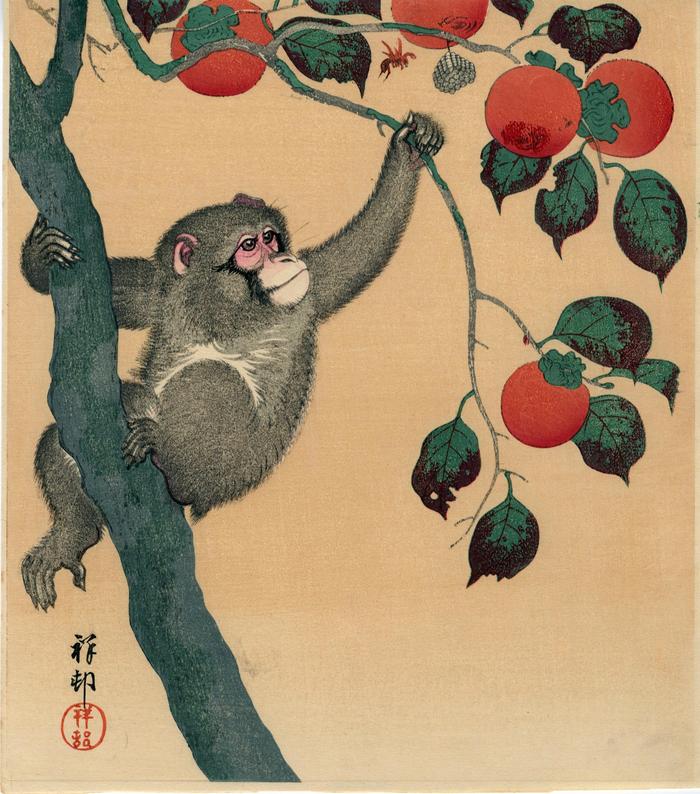Ohara Koson (小原古邨) / Shōson (祥邨) (artist 1877 – 1945)
"Monkey in a Persimmon Tree" ("Kaki ni Saru" - 柿に猿)
1935
9.5 in x 11 in (Overall dimensions) color woodblock print
Signed: Shōson (祥邨)
University of Michigan
Lyon Collection - a Koson print of a monkey holding a wasp by its stinger
Honolulu Museum of Art - gift of James Michener A little monkey seated on a persimmon tree branch reaches for a persimmon quite near a wasp's nest. Since the Japanese language is rife with pun, often based on words that are homophones or their near equivalents, one can bet that this image by Shōson is not as straightforward as it would appear. It can be viewed on several levels, but often in ways non-Japanese viewers would ever see immediately.
The field of 'bird and flower' images, kacho-e, has a long history in East Asian art. Koson/Shōson (1877-1945) was the greatest master of this style, which also included the representations of animals, in the 20th century. Before him there were a number of famous artists who tried their hand at this genre, Hokusai and Hiroshige before him. But the best of them was most definitely Mori Sosen (1747-1821: 森狙仙). At some point Sosen decided that he would have to go and live among the monkeys in their natural habitat, so he could observe their most natural moves. He did this for three years and during that time he mastered the ability to show their movements and interactions. He also how to delineate their fur accurately. Then when Sosen turned 60, a particularly important age in not only their calendar, but also psychologically. Traditionally the Chinese, Japanese and Koreans operated on a 60 year cycle, so the age of 60 came to mean a new beginning. According to the curatorial notes of the National Museum of Asian Art, Sosen "on his sixtieth birthday he actually changed a character of his name to mean “monkey” instead of “ancestor.” He is, therefore, the monkey painter of Japan."
We have added a jpeg of a painting by Sosen of three monkeys in the National Museum of Asian Art. One of them is probably the mother, looking up at two hovering wasps, while the two younger ones are oblivious to the danger at hand.
****
Illustrated
1) in black and white in Modern Japanese Prints: The Toledo Museum of Art by Dorothy Blair, 1997 (reprint of the 1936 catalog), pl. #209.
2) in a small color reproduction in Crow, Cranes, and Camellias: the Natural World of Ohara Koson 1877-1945, by Amy Reigle Newland, et al., #S41.5, p. 201.
****
Jerry Vegder wrote:
There is an exhibition right now of Edo Period paintings from the Price collection showing at the Sackler Gallery on the Mall in Washington, D.C. One of the works is a hanging scroll by Mori Sosen (1747-1821: 森狙仙 or もり・そせん) of a monkey 'tracking' a wasp. In a review in the Washington Post (November 15, 2007) Joe Price notes that this image is actually a visually pun. The words for wasp and fiefdom rhyme - hachi and hochi - as do the words for monkey and lord.* The moral: Watch out! If you are given a fiefdom by your lord you might get stung.
*My understanding of Japanese is not good enough to prove this concept right or wrong, but sometimes you just have to accept certain bits of information on faith. Besides, it sounds reasonable to me.
****
The publisher was Watanabe Shōzaburō.
Watanabe Mokuhan Bujitsu Gahō (渡邊木版美術画舗) (publisher)
modern prints (shin hanga - 新版画) (genre)
Shōwa era (昭和時代) (genre)
